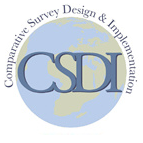- Home
- About us
- Initiatives
- Events
- 2024 CSDI Workshop
- Past Events
- 2023 CSDI Workshop
- 2022 CSDI Workshop
- 2021 Virtual CSDI Workshop
- 2019 CSDI Workshop
- 2018 CSDI Workshop
- 2017 CSDI Workshop
- 2016 3MC Conference
- 2015 CSDI Workshop
- 2014 CSDI Workshop
- Archive
- Forum
- Additional Resources
- Contact Us


Cross-Cultural Survey Guidelines
First published in 2008, the Cross-Cultural Survey Guidelines have recently undergone a significant update and expansion (Beta release: July 2016). The new edition includes over 800 pages of content with major updates and the expansion of all existing chapters, as well as the addition of new chapters on study design, study management, paradata, and statistical analysis. More than 70 professionals from 35 organizations contributed to this effort. The senior editor was Tom W. Smith of NORC at the University of Chicago. See: http://ccsg.isr.umich.edu/index.php/about-us/contributions for a complete list of contributors. The Cross-Cultural Survey Guidelines were developed to provide information on best practices across the survey lifecycle in a world in which the number and scope of studies covering multiple cultures, languages, nations, or regions has increased significantly. They were the product of an initiative of the International Workshop on Comparative Survey Design and Implementation (http://www.csdiworkshop.org/). The initiative was led by Beth-Ellen Pennell, currently the director of international survey operations at the Survey Research Center, Institute for Social Research at the University of Michigan. The aim of the initiative was to develop and promote internationally recognized guidelines that highlight best practice for the conduct of comparative survey research across cultures and countries. The guidelines address the gap in the existing literature on the details of implementing surveys that are specifically designed for comparative research, including what aspects should be standardized and when local adaptation is appropriate. The intended audience for the guidelines includes researchers and survey practitioners planning or engaged in what are increasingly referred to as multinational, multiregional, or multicultural (3MC) surveys, although much of the material is also relevant for single country surveys. The guidelines cover all aspects of the survey life cycle and include the following chapters: Study Design and Organizational Structure; Study Management; Tenders, Bids and Contracts; Sample Design; Questionnaire Design; Adaptation; Translation; Instrument Technical Design; Interviewer Recruitment, Selection, and Training; Pretesting; Data Collection; Paradata and Other Auxiliary Data; Data Harmonization; Data Processing and Statistical Adjustment; Data Dissemination; Survey Quality and Ethical Considerations. The guidelines can be found at: http://ccsg.isr.umich.edu. We welcome feedback and suggestions.
Center for Capacity Building in Survey Methods and Statistics Short Course Series
This short course series is sponsored by the International Statistical Institute, University of Michigan Center for Capacity Building in Survey Methods and Statistics. The mission of the Center is to:
- Promote excellence in survey and statistics research;
- Build research infrastructure;
- Support sound institutions; and
- Foster collaborative training and education
The courses are set up as ‘learn at your own pace’ and are not moderated. Each course is partitioned into topic modules. The topics are delivered via video(s) and each video has a corresponding quiz (auto-graded). The courses are intended as an introductory for each topic and include:
- Design and Implementation
- Project Management
- Introduction to Sampling
- Questionnaire Design: for surveys in 3MC Contexts
- General Interviewing Techniques
- Data Dissemination
WAPOR Webinar: Showcase of Free Online Courses and Guidelines
Looking to learn more about international and comparative cross-cultural surveys? Check out WAPOR’s recorded webinar, Showcase of Free Online Courses and Guidelines, presented by Zeina Mneimneh and Julie de Jong of the Survey Research Center International Unit at the University of Michigan.
Survey research carried out in international settings and in comparative cross-cultural contexts presents a set of unique methodological challenges. This presentation will showcase two resources facilitated by the Survey Research Center International Unit at the University of Michigan which are freely available for use by researchers and survey practitioners. The first resource is a series of online video short courses which provide introductory and foundational background for topics related to key stages of the survey life cycle and challenges faced in international surveys. The second resource is the Cross-Cultural Survey Guidelines, developed to promote internationally recognized best practices for the design and implementation of multinational, multicutural, and multiregional (3MC) surveys, covering all stages of the survey life cycle.